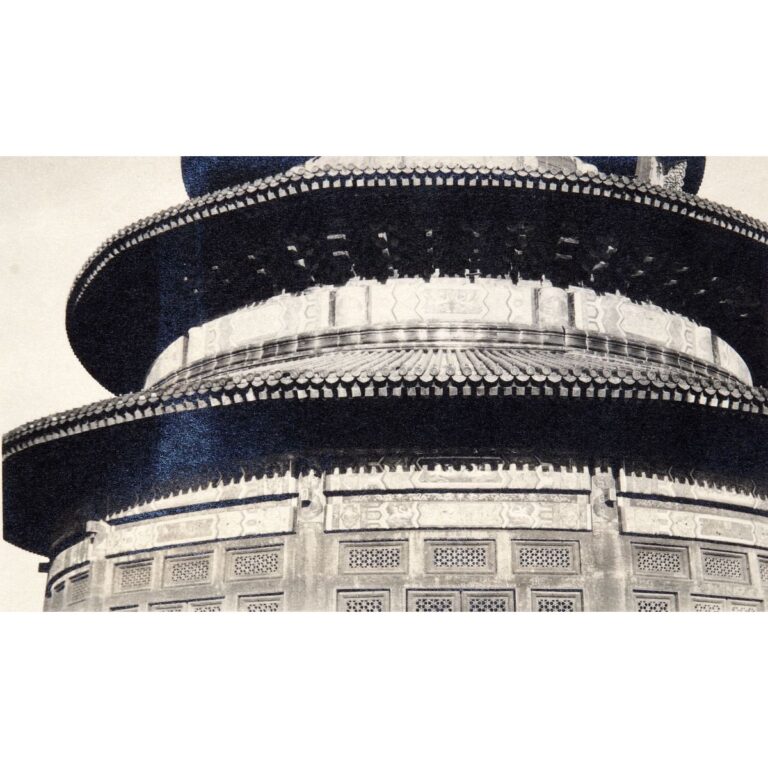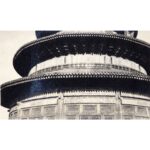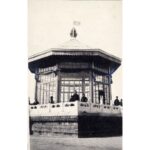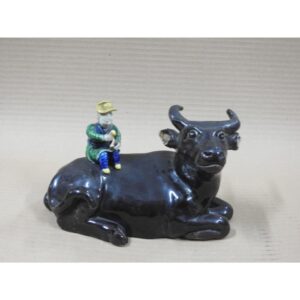Photography Details of the Qinian Hall at the Temple of Heaven
A black-and-white photograph showing interesting architectural and decorative elements on the façade of the central hall of the Temple of Heaven (Tiantan 天壇) in Beijing, i.e., the Qinian Hall (Qiniandian 祈年殿), which literally means “Hall of Annual Prayers”. It was built in 1420 by the Yongle emperor (reigned 1402–1424). It was here that the emperors of the Ming and Qing dynasties performed the rites of heavenly worship twice a year. In the Qinian Hall, on the day of the summer solstice, the emperor made offerings to Heaven and the ancestors and asked them for favour for the coming half year. In literature, the hall is often referred to by the popular name of “Prayer Hall for a Good Harvest”. Today it is the oldest and most iconic part of the entire complex. When it was decided in the 16th century that the rituals for heaven and earth should be performed separately, two more venues for the worship of heaven were built in the southern part of the complex. ... more
A black-and-white photograph showing interesting architectural and decorative elements on the façade of the central hall of the Temple of Heaven (Tiantan 天壇) in Beijing, i.e., the Qinian Hall (Qiniandian 祈年殿), which literally means “Hall of Annual Prayers”. It was built in 1420 by the Yongle emperor (reigned 1402–1424). It was here that the emperors of the Ming and Qing dynasties performed the rites of heavenly worship twice a year. In the Qinian Hall, on the day of the summer solstice, the emperor made offerings to Heaven and the ancestors and asked them for favour for the coming half year. In literature, the hall is often referred to by the popular name of “Prayer Hall for a Good Harvest”. Today it is the oldest and most iconic part of the entire complex. When it was decided in the 16th century that the rituals for heaven and earth should be performed separately, two more venues for the worship of heaven were built in the southern part of the complex. The last emperor to bow to heaven in the Temple was Yuan Shikai 袁世凱 (reigned 1915–1916), who for several months tried in vain to revive the monarchy. This marked the end of a centuries-old tradition. Today, the Temple of Heaven is on the UNESCO World Cultural Heritage List, as it is the largest religious complex in the world.
The circular temple has three round roofs with blue tiles, which symbolise the sky, and a gilded finial. Under the dowels, the walls are decorated with blue, yellow and green patterns symbolising the sky god, the emperor and the common people. The size of the roof decreases towards the top. 28 columns support the 38-metre high temple. It stands on a 6-metre high square platform with a balustrade. The number of platform layers and the number of balustrade columns are multiples of 9 – the number reserved for the imperial infrastructure.
All buildings in the complex were built using the traditional Chinese construction technique, the dougong 斗拱 system. In addition to the dowels in the eaves, other features of Chinese construction that can also be found in the Hall of Fasting are the shape of the roofs and the use of colours, numbers, and decorative animal figures. Although the shape prescribed for imperial infrastructure, including temples, was the quatrefoil (wudianding 廡殿頂), the temples in the Temple of Heaven and their roofs have a round shape (as in the Qinian Hall). The clue to the exception lies in the “exceptional” function of this complex, namely the worship of Heaven, which in Chinese tradition is symbolised by a circle. This complements the square that symbolises the Earth. The motif of square and circle as a symbol of harmonious creation is widespread in Chinese culture. This is why round temples also stand on square platforms. Another exception lies in the choice of colour for the roof tiles. The colour yellow was established by law for exclusive imperial use, and yellow roof tiles are found in the Forbidden City and the Summer Palace in Beijing. The Temple of Heaven, however, is covered with blue roof tiles, which also symbolise the sky.
The photograph is the 191st of 449 photographs of Beijing and its surroundings in the album of Ivan Skušek Jr., purchased during his stay in Beijing (1914–1920). In the handwritten inventory of the album, the photograph is referred to as Himmels-Tempel: Details des Haupttempels. (DZ, MV)





































Do you have a comment or additional information about the subject?